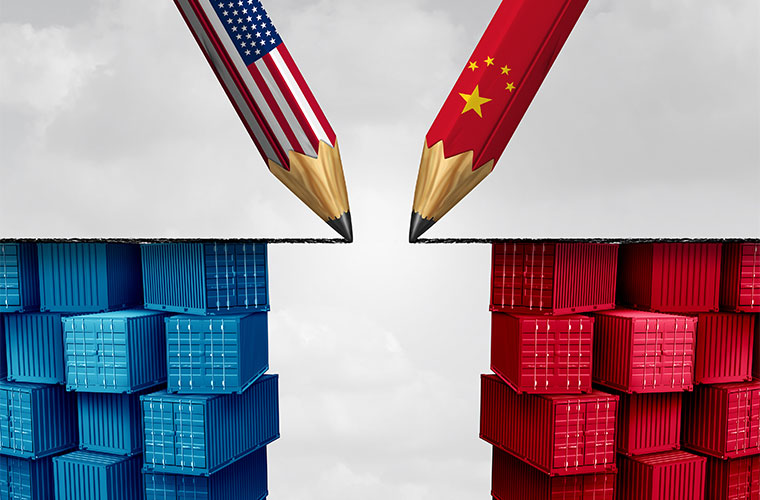By JOE McDONALD AP Business Writer
BEIJING (AP) — President Donald Trump’s threat to escalate tariffs on Chinese goods has clouded prospects for a trade agreement, though preparations by Beijing’s envoys to still visit Washington this week are buoying hopes for some breakthrough to end the trade war between the world’s two largest economies.
Beijing is “trying to get more information” after Trump’s announcement over the weekend that he would raise tariffs on $200 billion of Chinese imports from 10% to 25% on Friday, said a Foreign Ministry spokesman, Geng Shuang. Trump’s threat was seen as an effort to intensify pressure on Beijing to agree to a deal that would be to Trump’s liking.
Stock markets initially plunged Monday after Trump’s Sunday tweet over fears that China would abandon the latest round of talks in Washington, scheduled to resume Wednesday. U.S. stocks later regained some of their lost ground on hopes that the negotiations would proceed.
Still, Geng offered no details on when exactly the talks would resume or who would join the Chinese delegation. He would not say whether Vice Premier Liu He, who has led China negotiators in previous rounds, will travel to Washington.
The lack of details suggested that Beijing is wrestling with an internal conflict: Eager, on the one hand, to end a high-stakes trade fight that has battered Chinese exporters yet reluctant, on the other, to appear to bow to the Trump administration’s demands for far-reaching trade concessions.
“We hope the United States will join efforts with China and we can meet each other halfway so we make a mutually beneficial agreement on the basis of win-win and mutual respect,” Geng said.
The two governments have raised tariffs on hundreds of billions of dollars combined of each other’s goods in their dispute, which centers on the administration’s complaints about Chinese aggressive drive to achieve supremacy in global technology through illicit means. The confrontation has disrupted trade in goods ranging from soybeans to medical equipment.
Trump threats Sunday to raise import taxes on $200 billion in Chinese products from 10% to 25% — and impose tariffs on $325 billion of additional imports, in effect covering everything Beijing ships to the United States — raised the stakes. His administration has already imposed 25% tariffs on $50 billion of Chinese imports, while Beijing has imposed penalties on $110 billion of American goods.
On Monday morning, Trump stepped up his pressure, tweeting: “The United States has been losing, for many years, 600 to 800 Billion Dollars a year on Trade. With China we lose 500 Billion Dollars. Sorry, we’re not going to be doing that anymore!”
During Asian stock trading, China’s main stock index plunged 5.6 percent and Hong Kong lost 2.9 percent. Market benchmarks in France and Germany sank 2 percent. On Wall Street, the Dow Jones Industrial Average The Dow Jones Industrial Average was down around 240 points, or 0.9%, in early-afternoon trading. It had been down as much as 471 in the first few minutes of trading.
Previously, Trump had postponed deadlines for a trade agreement in an effort to buy more time for negotiations. But on Sunday, he complained on Twitter that a deal with Beijing was coming “too slowly, as they attempt to renegotiate. No!”
The suddenly combative rhetoric from Trump came as a surprise. For weeks, administration officials have been suggesting that negotiations were making steady progress.
Michael Pillsbury, director of the Hudson Institute’s Center on Chinese Strategy and an adviser to the Trump White House, said the president’s tweets suggest that Chinese leaders “are trying to take back concessions they already made.”
Trump had raised tariffs on Chinese imports on July 6 in response to complaints that Beijing steals or pressures foreign companies to hand technology. The administration and other trading partners also want Beijing to scale back plans for government-led creation of Chinese global competitors in robotics and other technology. They say those violate the communist government’s market-opening commitments.
Both sides say they are making progress, but no details have been released. Beijing’s negotiators have agreed to narrow the politically sensitive Chinese trade surplus with the United States by purchasing more soybeans, natural gas and other goods. They have offered to change industrial strategies but have ruled out discarding them outright.
Another sticking point is U.S. insistence on an enforcement mechanism with penalties in the event Beijing fails to stick to any commitments it makes.
Economists suggested Trump may want to step up pressure because China’s economy is improving, reducing the urgency for Beijing to strike a deal.
The latest quarter’s growth held steady despite a slump in exports to the United States. That suggested official efforts to reverse a downturn were gaining traction.
“China may have appeared less willing to offer additional concessions,” said Citigroup economists in a report.
Trump’s threat makes going ahead with talks “very difficult politically” for President Xi Jinping’s government, said Jake Parker, vice president of the U.S.-China Business Council. He said the Chinese public might “view this as a capitulation” if Beijing reached an agreement before Trump’s Friday deadline.
If Trump carries out his threat, American companies in China “would be very concerned” about official retaliation, said Parker.
A Chinese decision to pull out of talks could have global repercussions, causing turmoil in financial markets and dragging on economic growth, economists said.
“The risk of an all-out U.S.-China trade war has increased significantly,” Tao Wang and Ning Zhang of UBS said in a report.
___
AP Economics Writer Paul Wiseman in Washington contributed to this report.
